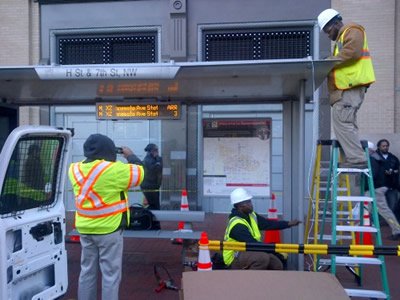By the end of 2015, nearly 180 bus stops along some of the region’s busiest bus corridors will feature new electronic arrival signs telling passengers in real time when their bus is due to arrive.
The signs are similar to those already in use at Metrorail stations, which tell passengers when the next few trains will arrive. A small number of bus stops in the region, including some near the Pentagon and in Montgomery County, already have such signs. Bus stops in many other U.S. and international cities feature such technology, too.
Just a few weeks ago, Metro installed initial test signs at four stops -- one each in Virginia and the District of Columbia, and two in Maryland. By the end of the year, Metro and other area transit agencies will install signs at 175 more stops, most of them along major bus corridors.
|

|
|
WMATA
|
In the District, signs will be installed along 16th Street NW, Georgia Avenue NW, Wisconsin Avenue NW, and H Street/Benning Road NE.
In Maryland, signs will go up at bus shelters along the highly traveled University Boulevard and Viers Mill Road corridors, and along Addison Road. Bus bays at the Pentagon and Franconia-Springfield stations in Virginia will see new signs, as will stops along the planned bus rapid transit corridor (BRT) between the Van Dorn and Pentagon Metro stations.
Real-time arrival signs offer another way for passengers to get up-to-date information on when their bus will arrive. Previously, passengers relied mainly on third-party smartphone apps or Metro’s automated call center to get such information.
Installation of the new signs is being funded under a federal TIGER grant awarded to the Transportation Planning Board in early 2010. In all, the grant is funding $58.8 million in improvements to make bus transit more reliable and convenient -- by helping buses bypass traffic back-ups, enhancing the safety and comfort of stops, stations, and vehicles, or providing customers with more real-time arrival information.
Other projects funded under the TPB’s TIGER grant include a portion of Metroway, the region’s first BRT line, which opened last year in Northern Virginia, and the Takoma-Langley Transit Center in Maryland, due to open this fall.
This year’s deployment of nearly 180 real-time arrival displays has required a high level of coordination among the many agencies that operate buses on routes that will see new signs. Differences in vehicle location technologies, data collection and transmission methods, and bus stop ownership and management all pose challenges in launching a fully integrated real-time display system.
Metro and other partner agencies hope to deploy signs at up to 400 more bus stops in coming years, though funding has yet to be identified.
Related Links